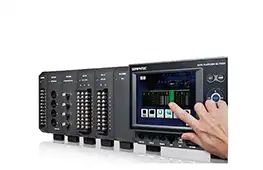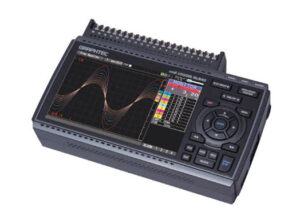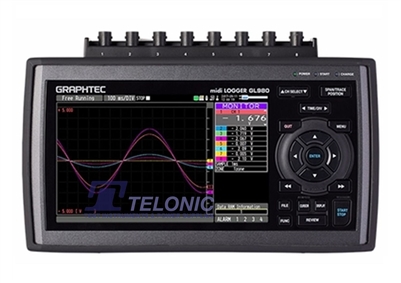Data loggers measure and record data over time or during a specific occurrence. They are helpful in monitoring equipment, processes, and other environmental factors to keep operators and maintenance staff aware of potential problems before they escalate. Acute awareness of operational performance can lead to more efficient production, safer facilities, reduced costs, and increased profitability. Choosing the correct data logger for your application can be challenging, with many options available. This blog post will explore some considerations when selecting a data logger and the types of data loggers, such as Graphtec Data loggers, temperature data loggers, etc.
What to Look for in a Data Logger?
 A few things to consider when selecting a data logger include recording accuracy, data storage and retention, electrical environment and durability, ease of use and operational features, Graphtec data, and temperature data logger. When selecting a logger, it’s essential to know how these factors can affect the data logger. How easy is connecting the data logger to equipment and other devices? How intuitive is the user interface? Temperature data loggers can be helpful in various industries where precise temperature readings are critical. This can include food processing, chemical manufacturing, medical, automotive, and more.
A few things to consider when selecting a data logger include recording accuracy, data storage and retention, electrical environment and durability, ease of use and operational features, Graphtec data, and temperature data logger. When selecting a logger, it’s essential to know how these factors can affect the data logger. How easy is connecting the data logger to equipment and other devices? How intuitive is the user interface? Temperature data loggers can be helpful in various industries where precise temperature readings are critical. This can include food processing, chemical manufacturing, medical, automotive, and more.
Recording Accuracy
When considering recording accuracy, you need to consider the accuracy of the entire data logging. This will depend on sensor accuracy, resolution, and the selection of the appropriate sampling rate for your application. While it’s essential to be aware of sensor accuracy, there are also considerations in the data logger itself. For example, is the resolution of the digital to analog converter (DAC) high enough to represent your data accurately? You should also consider the sampling rate of the Data Loggers. The sampling rate determines how often the data logger will take a measurement.
Data Storage and Retention
When you choose a data logger, you also need to consider how long it will keep the data. Having the data to make informed decisions is essential, but not so long that it becomes irrelevant. A good rule of thumb is to keep data for at least a year but no more than three. This can depend on the application and the type of data you are recording.
Electrical Environment and Durability
Suppose the data logger is in an electrically active environment. In that case, you may want to select a data logger with a rugged enclosure rated for those conditions. Regular wear and tear can reduce the lifespan of the data logger and make it less durable. If you’re using the data logger in an application that requires it to be outdoors, make sure it is rated for outdoor use.
Ease of Use and Operational Features
The data logger’s user interface will impact how quickly and easily you can start using the data to make informed decisions. Remember that the data logger itself may not be what controls the data but rather a software program that the data logger connects to. You should be able to join the data logger to equipment and other devices quickly and easily.
Types of Data Loggers
Temperature data logger
When selecting a data logger for applications that monitor temperature, one is whether you need a data logger that can record temperatures above 100 degrees Celsius or below -40 degrees Celsius. For a Temperature data logger Distributor, you must select a sensor to measure temperatures above or below the specified temperature range. You should also consider how the sensor will be mounted in the application. Many temperature data loggers have a sheath that covers the sensor to protect it from contamination.
Graphtec data logger
Suppose you monitor vibration, shock, pressure, or acceleration conditions. In that case, you may want to select a data logger with a built-in accelerometer if your data logger is exposed to a wide range of temperatures. In that case, you may want to choose a data logger with a high-temperature probe and a large backlit display if you are monitoring large equipment. If you plan to use your data logger in an area with high humidity, you may want to select a data logger with an IP rating of at least 68.
Graphtec data logger Gl840
 The Graphtec data logger Gl840 is designed for use in a variety of industrial applications. The data logger can be used in applications that require protection against vibration, shock, or pressure. The logger can also be used in applications that require protection against liquids or dust. The Gl840 can be used in a wide range of temperatures, from -40 degrees Celsius to 125 degrees Celsius. Users can quickly navigate through the data using the large backlit display. The data logger also has a built-in accelerometer. The Gl840 is easy to install and can be connected to a computer using the included USB cable. The logger comes with preloaded software that can be customized to meet your specific needs. The Graphtec data logger Gl840 is a good choice for machine monitoring, oil and gas exploration, process monitoring, and more.
The Graphtec data logger Gl840 is designed for use in a variety of industrial applications. The data logger can be used in applications that require protection against vibration, shock, or pressure. The logger can also be used in applications that require protection against liquids or dust. The Gl840 can be used in a wide range of temperatures, from -40 degrees Celsius to 125 degrees Celsius. Users can quickly navigate through the data using the large backlit display. The data logger also has a built-in accelerometer. The Gl840 is easy to install and can be connected to a computer using the included USB cable. The logger comes with preloaded software that can be customized to meet your specific needs. The Graphtec data logger Gl840 is a good choice for machine monitoring, oil and gas exploration, process monitoring, and more.
Data loggers are essential for monitoring equipment, processes, and other environmental factors. When selecting a data logger, you should look for one that is accurate, easy to use, and durable. The data logger should also be able to store data for an appropriate amount of time. When choosing a data logger, you should consider the above factors to select the best solution for your needs.


